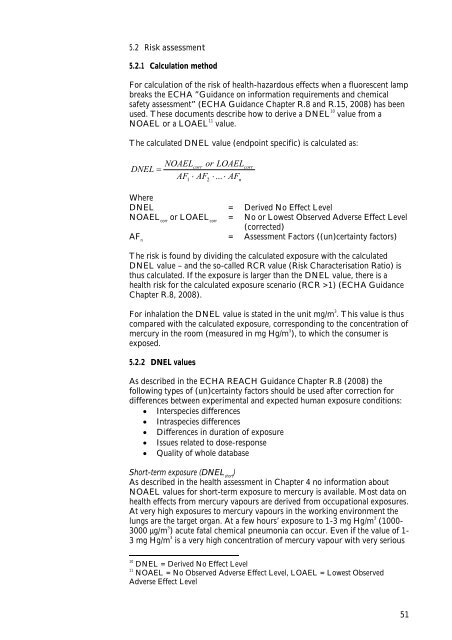No. 104 - Miljøstyrelsen
No. 104 - Miljøstyrelsen
No. 104 - Miljøstyrelsen
Create successful ePaper yourself
Turn your PDF publications into a flip-book with our unique Google optimized e-Paper software.
5.2 Risk assessment<br />
5.2.1 Calculation method<br />
For calculation of the risk of health-hazardous effects when a fluorescent lamp<br />
breaks the ECHA ”Guidance on information requirements and chemical<br />
safety assessment” (ECHA Guidance Chapter R.8 and R.15, 2008) has been<br />
used. These documents describe how to derive a DNEL 10 value from a<br />
NOAEL or a LOAEL 11 value.<br />
The calculated DNEL value (endpoint specific) is calculated as:<br />
NOAELcorr<br />
or LOAEL<br />
DNEL �<br />
AF � AF � ... � AF<br />
1<br />
2<br />
n<br />
corr<br />
Where<br />
DNEL = Derived <strong>No</strong> Effect Level<br />
NOAEL corr or LOAEL corr = <strong>No</strong> or Lowest Observed Adverse Effect Level<br />
(corrected)<br />
AF n = Assessment Factors ((un)certainty factors)<br />
The risk is found by dividing the calculated exposure with the calculated<br />
DNEL value – and the so-called RCR value (Risk Characterisation Ratio) is<br />
thus calculated. If the exposure is larger than the DNEL value, there is a<br />
health risk for the calculated exposure scenario (RCR >1) (ECHA Guidance<br />
Chapter R.8, 2008).<br />
For inhalation the DNEL value is stated in the unit mg/m 3 . This value is thus<br />
compared with the calculated exposure, corresponding to the concentration of<br />
mercury in the room (measured in mg Hg/m 3 ), to which the consumer is<br />
exposed.<br />
5.2.2 DNEL values<br />
As described in the ECHA REACH Guidance Chapter R.8 (2008) the<br />
following types of (un)certainty factors should be used after correction for<br />
differences between experimental and expected human exposure conditions:<br />
� Interspecies differences<br />
� Intraspecies differences<br />
� Differences in duration of exposure<br />
� Issues related to dose-response<br />
� Quality of whole database<br />
Short-term exposure (DNEL ) short<br />
As described in the health assessment in Chapter 4 no information about<br />
NOAEL values for short-term exposure to mercury is available. Most data on<br />
health effects from mercury vapours are derived from occupational exposures.<br />
At very high exposures to mercury vapours in the working environment the<br />
lungs are the target organ. At a few hours’ exposure to 1-3 mg Hg/m 3<br />
(1000-<br />
3000 µg/m 3 ) acute fatal chemical pneumonia can occur. Even if the value of 1-<br />
3 mg Hg/m 3<br />
is a very high concentration of mercury vapour with very serious<br />
10<br />
DNEL = Derived <strong>No</strong> Effect Level<br />
11<br />
NOAEL = <strong>No</strong> Observed Adverse Effect Level, LOAEL = Lowest Observed<br />
Adverse Effect Level<br />
51

















